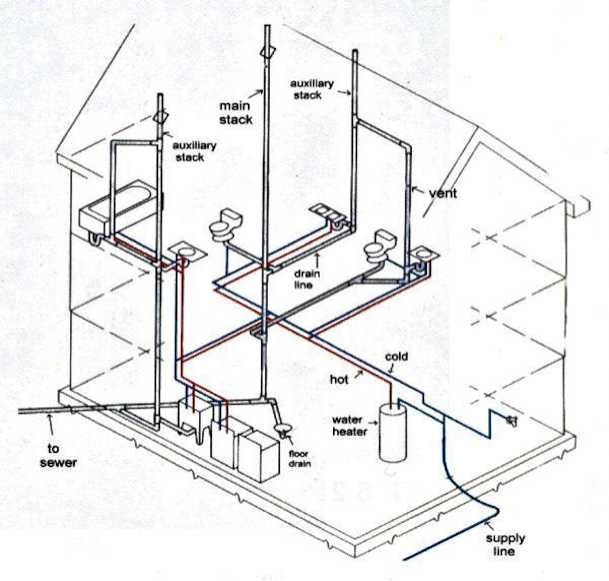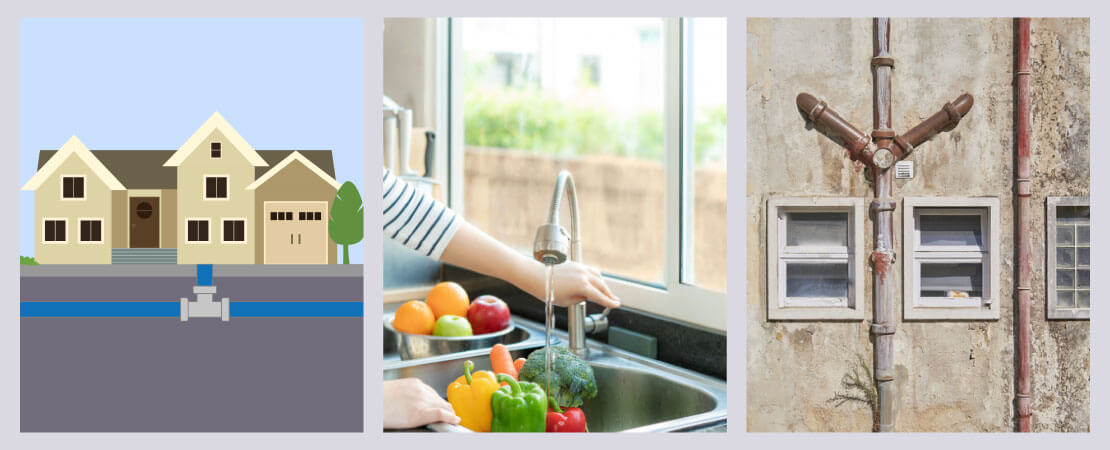Exploring Your House's Plumbing System Anatomy
Exploring Your House's Plumbing System Anatomy
Blog Article
The publisher is making several great points regarding Anatomy of a House: Understanding the Components in general in the article followed below.

Recognizing exactly how your home's plumbing system works is vital for every house owner. From providing tidy water for alcohol consumption, cooking, and showering to safely getting rid of wastewater, a well-kept pipes system is essential for your family members's health and wellness and convenience. In this comprehensive overview, we'll discover the elaborate network that comprises your home's pipes and offer ideas on upkeep, upgrades, and handling typical concerns.
Introduction
Your home's pipes system is greater than just a network of pipelines; it's a complicated system that ensures you have accessibility to clean water and reliable wastewater elimination. Knowing its elements and just how they interact can help you stop pricey repairs and make sure every little thing runs smoothly.
Basic Parts of a Pipes System
Pipelines and Tubes
At the heart of your pipes system are the pipelines and tubes that bring water throughout your home. These can be made from numerous products such as copper, PVC, or PEX, each with its benefits in terms of resilience and cost-effectiveness.
Fixtures: Sinks, Toilets, Showers, etc.
Components like sinks, commodes, showers, and bathtubs are where water is used in your house. Recognizing exactly how these fixtures connect to the plumbing system aids in detecting troubles and preparing upgrades.
Valves and Shut-off Factors
Shutoffs control the flow of water in your plumbing system. Shut-off shutoffs are vital throughout emergencies or when you need to make repair work, allowing you to separate parts of the system without disrupting water flow to the whole residence.
Water System
Key Water Line
The primary water line links your home to the local water or an exclusive well. It's where water enters your home and is dispersed to different fixtures.
Water Meter and Stress Regulatory Authority
The water meter steps your water usage, while a stress regulatory authority guarantees that water flows at a risk-free pressure throughout your home's pipes system, stopping damage to pipelines and components.
Cold Water vs. Hot Water Lines
Understanding the distinction in between cold water lines, which provide water directly from the major, and hot water lines, which carry warmed water from the hot water heater, assists in troubleshooting and preparing for upgrades.
Drain System
Drain Piping and Traps
Drain pipes carry wastewater away from sinks, showers, and commodes to the drain or septic tank. Catches prevent sewage system gases from entering your home and also trap particles that could trigger clogs.
Air flow Pipes
Ventilation pipelines permit air into the drain system, preventing suction that might slow drain and create traps to vacant. Proper ventilation is essential for preserving the honesty of your plumbing system.
Relevance of Appropriate Water Drainage
Guaranteeing correct drain prevents back-ups and water damage. Routinely cleaning up drains and preserving traps can avoid expensive repairs and prolong the life of your pipes system.
Water Heating System
Kinds Of Hot Water Heater
Hot water heater can be tankless or traditional tank-style. Tankless heating units warm water as needed, while tanks keep warmed water for immediate use.
Upgrading Your Pipes System
Reasons for Upgrading
Updating to water-efficient components or changing old pipes can boost water top quality, decrease water bills, and boost the worth of your home.
Modern Pipes Technologies and Their Benefits
Discover technologies like wise leakage detectors, water-saving commodes, and energy-efficient hot water heater that can save money and decrease ecological impact.
Cost Considerations and ROI
Compute the ahead of time prices versus lasting cost savings when taking into consideration pipes upgrades. Several upgrades pay for themselves through decreased utility expenses and less fixings.
How Water Heaters Connect to the Plumbing System
Understanding how water heaters link to both the cold water supply and warm water circulation lines assists in detecting concerns like not enough warm water or leakages.
Upkeep Tips for Water Heaters
Frequently flushing your water heater to eliminate sediment, checking the temperature settings, and examining for leaks can extend its lifespan and improve energy efficiency.
Usual Pipes Issues
Leaks and Their Reasons
Leakages can happen because of aging pipelines, loosened fittings, or high water pressure. Addressing leakages without delay protects against water damages and mold and mildew development.
Blockages and Blockages
Clogs in drains pipes and bathrooms are frequently triggered by flushing non-flushable things or an accumulation of grease and hair. Making use of drainpipe screens and being mindful of what goes down your drains pipes can avoid clogs.
Indicators of Plumbing Problems to Expect
Low water pressure, slow drains, foul odors, or abnormally high water costs are indications of potential pipes issues that must be dealt with promptly.
Pipes Maintenance Tips
Normal Assessments and Checks
Schedule yearly pipes evaluations to catch problems early. Look for indicators of leaks, deterioration, or mineral accumulation in faucets and showerheads.
Do It Yourself Maintenance Tasks
Simple jobs like cleaning tap aerators, checking for commode leaks making use of dye tablet computers, or protecting exposed pipelines in cold environments can avoid significant pipes issues.
When to Call a Specialist Plumbing
Know when a pipes issue needs professional know-how. Attempting complicated fixings without appropriate knowledge can cause even more damage and higher fixing costs.
Tips for Minimizing Water Use
Simple behaviors like repairing leakages without delay, taking shorter showers, and running full tons of washing and dishes can save water and reduced your utility bills.
Eco-Friendly Plumbing Options
Take into consideration lasting plumbing materials like bamboo for floor covering, which is durable and eco-friendly, or recycled glass for counter tops.
Emergency situation Readiness
Actions to Take During a Plumbing Emergency
Know where your shut-off shutoffs are located and exactly how to shut off the water in case of a burst pipe or major leak.
Relevance of Having Emergency Contacts Useful
Keep get in touch with details for neighborhood plumbers or emergency services easily offered for fast action throughout a pipes situation.
Environmental Impact and Conservation
Water-Saving Fixtures and Appliances
Installing low-flow faucets, showerheads, and toilets can considerably decrease water use without giving up efficiency.
Do It Yourself Emergency Situation Fixes (When Suitable).
Momentary repairs like utilizing air duct tape to patch a leaking pipeline or positioning a pail under a trickling tap can decrease damage till a professional plumber arrives.
Conclusion.
Understanding the makeup of your home's plumbing system empowers you to maintain it effectively, conserving money and time on repair services. By complying with routine maintenance routines and staying educated concerning contemporary plumbing technologies, you can guarantee your plumbing system runs effectively for many years to find.
HOW YOUR PLUMBING SYSTEM WORKS
Which Pipes Do What?
Blue lines = fresh water supply entering the building Red lines = hot water supply entering the building Grey lines = pipes carrying waste away from the building and venting pipes carrying gases away from the building (through the roof) YOUR MAIN PLUMBING SYSTEMS
There are two main plumbing systems that support your home s basic plumbing needs one that brings clean water into your home, and one that sends dirty water away from your home. Connected to the toilet, bath, shower, and other faucets in your home, these two systems keep your water flowing in the right directions.
ACCESSING FRESH WATER
Fresh and clean water is brought into your home through the main water supply line . Filtered through one pipe, this water is pressured to flow into the various fixtures in your home at any given time.
This water can be sourced from a well located on your property, a pond or river (mostly cottages), or, as in most cases, from the city s municipal water treatment centre. However, it is important to note that water that is untreated, such as the water siphoned from ponds or rivers, may not be safe to drink. Personal water supplies always need to be treated for hardness and contaminants before consumed.
MUNICIPAL WATER SUPPLIES
Improve taste and odour Remove sediment Eliminate hardness Reduce chlorine COLD WATER SUPPLY VS. HOT WATER SUPPLY
Cold water flows into your home or building through the service line, which then distributes hot or cold water to your fixtures. This line is most commonly run through a central column that runs floor to floor. Hot water runs in short and straight pipes as the longer the pipeline, the more heat that will be lost in the transfer. Having shorter pipes also allows residents to access hot water more quickly.
WASTE WATER SYSTEM
Your wastewater system is divided into two parts pipes that send wastewater away from your home and venting pipes that send sewer gas away from your home. Sewage water travels through pipes that flush the water and waste towards local sewers that are operated and managed by your city or town. Most sewer systems rely on gravity to move the wastewater to where it needs to go.
The further away from your toilet or sink, the larger wastewater pipes become. This allows for waste to be disposed of from various parts of your home or business at once without pipe blockages. The angle and flow of these pipes are also essential for keeping your waste pipes clear of build up.
https://harrisplumbing.ca/how-your-home-plumbing-system-works/

I hope you liked our excerpt on . Thank you for spending some time to read through our posting. Appreciated our piece? Please share it. Help others check it out. Thanks a lot for being here. Don't forget to come visit our blog back soon.
Call Today Report this page